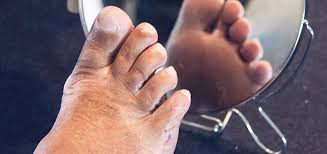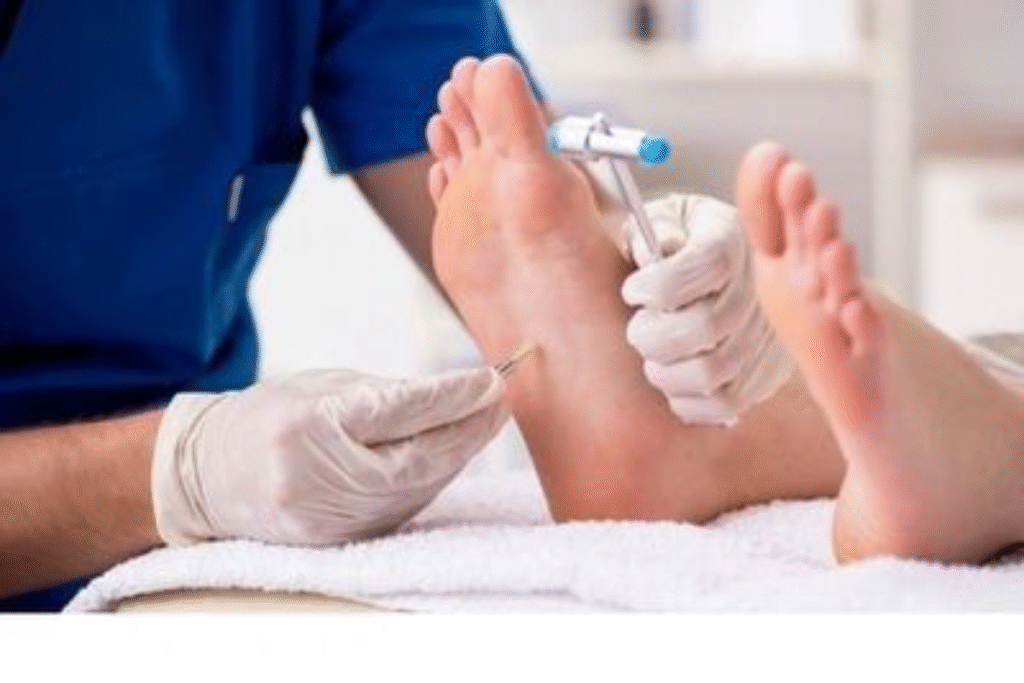Worried about diabetic foot problems? Learn how a quick 3-minute diabetic foot exam can spot nerve issues, poor circulation, and foot ulcers early. Easy tips, expert advice, and everyday care to keep your feet strong and pain-free!
What Is a Diabetic Foot Exam and Why It Matters
If you have diabetes, your feet need a little extra love and attention — and that’s where a diabetic foot exam comes in. Think of it as your foot’s “check-up.” Just like you visit the doctor to check your heart or eyes, your feet also need regular screening to make sure they stay healthy and strong.
A diabetic foot exam is a quick, painless way to look for early signs of nerve damage, poor blood flow, or foot ulcers. These problems can sneak up quietly, but catching them early helps prevent serious issues — like infections, wounds, or even amputation. It’s not meant to scare you; it’s meant to protect you.
During the exam, a healthcare professional checks the skin, nails, blood circulation, and sensation in your feet. They might use a small tool called a monofilament to test how well you can feel touch or use a tuning fork to check vibration perception. These simple tests show if there’s loss of protective sensation (LOPS) — an early sign that nerves in your feet are being affected by diabetes.
In most cases, the whole foot screening takes less than 10 minutes, and for some people, it’s part of a 3-minute diabetic foot exam that fits right into a routine doctor’s visit. That’s a small amount of time for something that can save your feet — and your peace of mind.
According to medical experts, people with diabetes should have at least one comprehensive foot exam each year. Those with existing foot problems may need more frequent risk asshttps://freshhealthglow.com/essments to keep complications at bay.
So, if you’ve been putting it off, consider this your friendly reminder: your feet carry you everywhere — they deserve care, comfort, and attention. A simple diabetic foot examination can make all the difference between healthy steps and painful setbacks.
Signs That You May Need a Diabetic Foot Exam
Your feet have a way of talking to you — not with words, but with little warning signs. If you have diabetes, paying attention to those signs could literally save your steps. A diabetic foot exam isn’t just for people already facing foot problems. It’s for anyone who wants to prevent them before they start.

Here are some red flags your feet might be sending:
- Numbness or Tingling:
If your feet often feel like they’ve “fallen asleep,” it could mean nerve damage or loss of protective sensation (LOPS). This makes it harder to feel pain, pressure, or temperature changes — and that’s risky because you might not notice small cuts or blisters. - Slow-Healing Wounds or Sores:
A small blister or cut that refuses to heal could be a sign of poor blood flow or infection. Even tiny wounds can turn into foot ulcers if left untreated. - Cold Feet or Color Changes:
If your feet feel unusually cold, pale, or bluish, your circulation might not be as strong as it should be. That’s a common sign of vascular issues in people with diabetes. - Swelling or Redness:
Any swelling, redness, or warmth could be your body’s way of signaling inflammation or infection. It’s better to get it checked sooner rather than later. - Pain or Burning Sensation:
If your feet hurt for no clear reason — especially at night — you might be developing peripheral neuropathy, a type of nerve damage caused by diabetes.
If any of these sound familiar, don’t wait for the problem to grow. Schedule a diabetic foot examination with your doctor or podiatrist. They’ll perform a quick foot screening — often a 3-minute diabetic foot exam — to check for nerve and vascular health, monofilament sensation, and risk factors for future complications.
Remember: you don’t have to feel pain to have a problem. Many diabetic foot issues start silently. Listening to your feet and taking early action is the smartest way to stay healthy, mobile, and confident on your journey with diabetes.
What Happens During a Diabetic Foot Exam (Step-by-Step)
So, what actually happens during a diabetic foot exam? Don’t worry — it’s simple, painless, and usually takes less than 10 minutes. Your doctor or nurse will gently check your feet to look for signs of nerve damage, poor blood flow, or skin problems that could lead to foot ulcers.
Here’s what you can expect, step by step
1. Visual Inspection
The first thing your healthcare provider will do is look closely at your feet. They’ll check the skin, nails, and the spaces between your toes for cuts, blisters, red spots, swelling, or calluses. These small changes can reveal early signs of infection or pressure areas that might turn into wounds later.
2. Sensation Testing
Next comes the monofilament test — one of the most common parts of a diabetic foot examination. Your doctor uses a thin nylon fiber (called a monofilament) to touch different spots on your foot. You’ll simply say “yes” every time you feel the touch. This helps check for loss of protective sensation (LOPS), which tells whether your nerves are still working properly.
Sometimes, a vibration perception test is also done using a small tuning fork. This test checks your ability to feel gentle vibrations — another way to spot nerve damage early.
3. Circulation and Pulse Check
The next step is to assess blood flow. The provider will feel for foot pulses and may compare both feet to see if circulation is strong and equal. Good blood flow keeps your feet warm, pink, and healthy — while poor circulation can make wounds heal slowly or cause cold feet.
4. Musculoskeletal and Foot Structure Exam
Your doctor might also check how your feet are shaped — the arches, toes, and joints. Sometimes, long-term diabetes can change the structure of your feet, leading to deformities or pressure points that increase the risk of foot ulcers.
5. Risk Assessment and Guidance
Finally, the doctor will explain what they found, talk about your foot care routine, and suggest next steps. This could include daily foot checks at home, better-fitting shoes, or a yearly foot screening to track changes.
A diabetic foot exam is one of the simplest ways to protect yourself from major complications. In just a few minutes, you can spot problems before they start — and take steps toward healthier, happier feet.
How Often Should You Get a Diabetic Foot Exam (and Who Should Do It)
When it comes to your feet, consistency is key. A single diabetic foot exam is helpful — but regular exams are what truly keep your feet safe and strong.
Most medical experts, including the American Diabetes Association (ADA), recommend that everyone with diabetes should have a complete diabetic foot examination at least once a year. That’s right — just once every 12 months can make a big difference.
However, if you already have nerve damage, poor blood flow, foot ulcers, or loss of protective sensation (LOPS), you may need foot screenings more often — sometimes every 3 to 6 months. Your doctor will decide what’s best for you based on your risk level.
Who Should Perform a Diabetic Foot Exam?
A diabetic foot exam is usually done by a doctor, nurse, or podiatrist — a specialist who focuses on foot health. In some cases, endocrinologists or diabetes educators may also perform foot assessments as part of your overall diabetes care plan.
These professionals are trained to check for nerve problems, poor circulation, and signs of infection or deformities. They know exactly what to look for — even the tiniest clues that something might be wrong.
Why Regular Exams Matter
Skipping a diabetic foot examination might not seem like a big deal, especially if your feet feel fine. But here’s the truth — many serious foot problems start silently. You may not feel pain even when there’s an issue developing under the skin.
A 3-minute diabetic foot exam can uncover hidden nerve damage or circulation issues before they turn into serious complications. Think of it as early warning for your feet — a quick, preventive step that can save you from foot ulcers, infections, or even amputation in the future.
So, don’t wait until there’s a problem. Make your foot screening part of your yearly health routine. After all, healthy feet mean freedom — freedom to walk, run, and live your life without limits.
Tips to Care for Your Feet Between Exams
A diabetic foot exam is important — but what you do between visits matters just as much. Taking care of your feet every day helps prevent nerve damage, foot ulcers, and infections, keeping you one step ahead of diabetes complications.
Here are some simple and effective foot care tips to keep your feet healthy and happy all year round
1. Check Your Feet Daily
Every night, take a minute to look at your feet. Check the tops, bottoms, and between your toes for cuts, blisters, red spots, or swelling. If you find something unusual, don’t ignore it — call your doctor. Remember, small problems can turn into big issues if left untreated.
2. Wash and Dry Carefully
Wash your feet daily with warm (not hot) water and mild soap. Dry them gently, especially between the toes. Moisture can lead to fungal infections, so make sure your feet stay clean and dry.
3. Keep Your Skin Soft
Use a light moisturizer or lotion on the tops and bottoms of your feet to prevent dryness and cracking. But avoid putting lotion between your toes, as that area needs to stay dry to prevent infection.
4. Trim Nails with Care
Keep toenails short and straight across. Avoid cutting too close to the skin or digging into corners — that can cause ingrown nails or inflammation. If you can’t trim them safely, ask your podiatrist to help.
5. Choose Comfortable Shoes
Wear well-fitted shoes that protect your feet and allow air circulation. Avoid tight or pointed shoes that cause pressure points. Soft, cushioned footwear can help prevent calluses, blisters, and ulcers.
6. Avoid Walking Barefoot
Even indoors! Stepping on a tiny object or sharp edge could cause an injury you may not even feel due to loss of protective sensation (LOPS). Always wear shoes or slippers for safety.
7. Stay Active and Keep the Blood Flowing
Light exercises like walking or stretching your toes can improve circulation and reduce poor blood flow. Keeping your legs elevated while sitting can also help.
A few minutes of daily foot care can make a lifetime of difference. Combine it with your regular diabetic foot examinations and foot screenings, and you’ll have a powerful routine to protect your mobility and confidence.
The Bottom Line – Protect Your Feet, Protect Your Future
Your feet tell your story every day — from your first steps in the morning to the last at night. For someone living with diabetes, those steps deserve extra care and attention. That’s where the diabetic foot exam becomes your best ally.

A simple 3-minute diabetic foot exam or yearly foot screening can catch small issues before they become serious. It helps detect nerve damage, poor blood flow, foot ulcers, and infection long before they lead to painful or costly complications. It’s quick, painless, and could save your mobility — or even your life.
The truth is, diabetic foot examinations aren’t just about checking feet — they’re about protecting your freedom. Every step you take without pain or worry is a step toward a better, more confident you.
But remember, exams work best when paired with daily foot care. That means washing, drying, and checking your feet every day, wearing proper shoes, and calling your podiatrist at the first sign of trouble. Prevention isn’t complicated — it’s about staying consistent and aware.
Think of your foot screening as a safety net, not a chore. The few minutes you spend on your diabetic foot exam today could prevent months of recovery tomorrow. With a little care, you can keep doing the things you love — walking, working, and living life fully.
So, take that first step right now. Book your diabetic foot exam, start a simple foot care routine, and protect your feet — because healthy feet mean a healthy, confident future.




